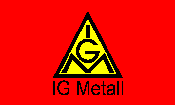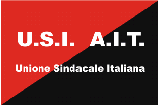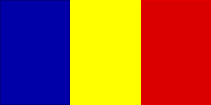- TRADE UNION BANNER
- See banner 3).
- TRADE UNION FLAG
- A flag, as opposed to a banner as defined herein, that is representative of a trade union or an affiliation
of such unions (see also banner 3)).



Metal Industry Union, Germany (fotw); General Labour Confederation, Columbia (fotw); Union of Italian Trade (fotw)
Please note that, in both historical and/or contemporary terms, a trade
union flag and a political flag can often be very closely linked see
political flag 2).
- TRAILING
- 1) In UK military and some other usage, a term for marching with a colour
or flag dragging on the ground, or standing in that position, and is employed
as a mark of respect to the head of state at funerals or as a token of victory in a parade of captured
enemy colours but see vailing
(also dipping 1)).
- 2) An uncommon method of saluting using a flag hoisted on a pole - the flag
is lowered until it just touches the ground for a few seconds, and then raised
smartly - practiced in some monarchies as a salute to a member of the royal family.
- TRAILING EDGE
- An alternative term for the sinister edge of a vertically hung banner or a gonfalon see
sinister edge.
Please note, that this term has been introduced by the Editors as a vexillogical
alternative to the heraldically derived sinister edge.
- TRANSARTAT
- A medieval term, now obsolete, for a banner on a crossbar.
- TRANSFIXED
- The heraldic term used when a charge or animal has been pierced with an arrow, sword, lance or other
weapon (see also pierced 2)).





Flag of Wolfenschiessen, Switzerland (fotw); Flag and Arms of Lipnica, Poland (fotw);
Flag and Arms of Sencur, Slovenia
- TRANSPOSED
- See reversed 2).
- TRANSVERSANT (or TRANSVERSE)
- A heraldically derived term for when the charge on a flag is shown as being rotated 90
degrees from the position in which it is usually seen.
![[transversant cross example]](../images/v/vxt-d614.gif)
![[transversant shield example]](../images/v/vxt-d614a.gif)
- TRAPEZOID (or TRAPEZIUM)
- 1) A charge similar to a triangle but with the apex squared, as in the flag of
Kuwait (see also triangle).
- 2) The term used to describe a triangular pennant whose apex is squared (see also
pennant 2).
![[Kuwait - Trapezium example]](../images/v/vxt-d323.gif)

National Flag of Kuwait (fotw); Pennant of the Yacht Racing Union of the Great Lakes, US (fotw)
- TREFOIL
- The heraldic term for a charge in the form of a stylized flower or plant with three
petals or leaves, and which is almost invariably shown bearing a stalk (see also
cinquefoil,
cloverstems,
cross botonny in appendix VIII and
quatrefoil)



From left: Mladenovac, Serbia; Malkov, Czech Republic; Trpinja, Croatia (fotw)
Please note that a cloverleaf and the traditional Irish emblem
a shamrock are also a trefoils.
- TREFOIL (or TREFLEE) CROSS
- See cross bottony in appendix VIII.
- TRESSURE
- See double-tressure, (also
orle and following note).
- TRIANGLE
- An almost invariably horizontal charge whose apex lies along the meridian,
and which may extend up to or slightly exceeding one-half the length of a
flag, but whose base usually occupies the full width of the hoist a simple
or hoist-triangle. When the base is on the fly it may be called a reversed or
fly-triangle, when parallel to the lower edge of a flag it may be called an
upright triangle and when parallel to the upper edge an inverted triangle,
but in these latter two cases the base generally occupies only a proportion of
a flag or panels length (see also meridian).



Flag of Kαjov, Czech Republic (fotw); Flag of Bahia, Brazil (fotw); National Flag of St Lucia
Please note, however, that a triangle whose apex
and base touch opposite edges of the flag should be considered a pile (see
pile).
- TRIANGLE THROUGHOUT
- See pile 1).
- TRIANGULAR-ENDED
- A term used to describe the fly of a flag or bottom edge of a gonfalon when it is
in the form of a straight-sided triangle (see also
gonfalon 1) and
triangular-ended tails below).
![[gonfalon showing triangular-ended]](../images/v/vxt-d511.gif)
Gonfalon of Bonjaci, Croatia (Željko Heimer)
- TRIANGULAR-ENDED TAILS (or TONGUES)
- A term used to describe the fly of a flag or bottom edge of a gonfalon that is
cut into two or more straight-sided tails or tongues with triangular ends (see also
gonfalon 1),
square-tailed
tongue(s) and
and triangular-ended above).
![[Triband example]](../images/v/vxt-d326.gif)
Gonfalon of Labor, Croatia (Željko Heimer)
- TRIBAL FLAG
- The sub-national flag of any group which shares an ethnic origin, but which is not
internationally recognized as independent but see
national flag 2) and
political flag 1)
(also sub-national flag).
![[tribal flags illustration]](../images/v/vxt-d512.gif)
From left: Navaho Nation, US (fotw); Arapaho Nation, US (fotw);
Chickasaw Nation, US (fotw)
Please note that a tribal flag may also be a political flag
under certain circumstances, and that some tribal flags may be considered as national flags
dependent upon the legal status and/or ambitions of the tribal group concerned.
![[tribal flags which serve as political or national flags]](../images/v/vxt-d512a.gif)
From left: The Kurds, Iraq (fotw); The Aboriginals, A National
Flag of Australia Under The Law (CS)
- TRIBAND (or TRI-BAND)
- 1) A flag of three parallel stripes or bands but using only two colours. These stripes may be disposed
vertically, horizontally or diagonally, be of equal or unequal width and be either defaced or plain
a three-striped flag or tiercι (see also
deface,
plain 2),
stripe,
striped,
tiercι,
tricolour and width 2)).
- 2) An undefaced flag with three equal parallel stripes or bands using two colours a simple triband
(see also undefaced).
- 3) Informally, any flag of three parallel stripes or bands in either two colours or three. These stripes
may be disposed vertically, horizontally or diagonally, be of equal or unequal width and be either defaced or
plain but see notes below.
|
![[Triband example]](../images/v/vxt-d327.gif)
National Flag of Nigeria (fotw)
|
![[Triband example]](../images/v/vxt-d327c.gif)
Flag of Norfolk Island (fotw)
|
![[Triband example]](../images/v/vxt-d327a.gif)
Flag of Andalusia, Spain
(fotw)
|
![[Triband example]](../images/v/vxt-d327b.gif)
Flag of Parana, Brazil,
1892-1905 (fotw)
|
Please note with regard to 1) and 2), that the Editors have
drawn a distinction between flags with three parallel stripes and three colours and those having
three parallel stripes and only two colours, with the definitions for tricolour and triband having
been carefully drawn up using all available sources, however, please see further note below.
With regard to 3) it should be further noted that this definition
includes not only all flags detailed in 1) and 2) above, but also those described under tricolour,
and it is strongly suggested that these entries be consulted before usage.
- TRIBAR
- A term sometimes applied to a flag of three stripes.
Please note however, before using this term it is
suggested that the entry on bar in Appendix VI and/or
a suitable glossary or heraldic dictionary be consulted.
- TRICOLORE, LA
- The national flag of Italy, see tricolour 2).
- TRICOLORE, LE
- The national flag of France, see tricolour 2).
- TRICOLOUR (or TRICOLOR)
- 1) See also
deface,
plain 2), stripe,
striped, tiercι,
triband and width 2)).
- 2) 2) An undefaced flag with three equal parallel stripes or bands of different colours
a simple tricolour for example: the national flag of France - le tricolore,
the national flag of Italy - la tricolore or that of the Netherlands
- the driekleur - but see the second note below (also
undefaced and
princeflag).
![[Tricolor example]](../images/v/vxt-d329.gif)
![[Tricolor example]](../images/v/vxt-d329a.gif)
![[Tricolor example]](../images/v/vxt-d329b.gif)
![[Tricolor example]](../images/v/vxt-d329c.gif)
![[Tricolor example]](../images/v/vxt-d329d.gif)
National Flag of France (CS); National Flag of the Netherlands; National Flag
of the Congo (fotw); National Flag of Ecuador (fotw); National Flag of St
Vincent (fotw)
Please note that the definition of tricolour (as
given herein) is restricted to flags of three colours disposed in three
parallel stripes,
and that flags that do not fall into this category are defined elsewhere. The Editors have
also drawn a distinction between flags with three parallel stripes and three colours, and those consisting of three
parallel stripes but only two colours, with the definitions for tricolour and triband having been carefully
drawn up using all available sources, however
this distinction is not always observed (see also triband 3)).
With regard to 2) please also note that many national flags, in addition to the three examples given above,
are referred to as a tricolour in their respective languages.
- TRINITARIAN CROSS
- A term that is used to describe the (layered) cross of the Catholic Order of the Holy Trinity
in which a blue horizontal arm is overlaid by a red vertical. (see also
'layered cross' and
'layered saltire').

The Order of the Holy Trinity (Wiki)
- TRIPARTITE (TRIPARTED or TRIPLE-PARTED)
- The term for a charge, particularly (but not exclusively) a cross or
saltire, that is divided longitudinally into three parts in three different
colours, as in the flag of Dominica triparted or triple-parted (see also
cross 3),
layered cross and
layered saltire).
![[Dominica - Tripartite example]](../images/v/vxt-d331.gif)
![[Guatavita Colombia]](../images/v/vxt-d331a.gif)
From left: National Flag of Dominica (fotw); Flag of Guatavita, Colombia (fotw)
- TRIPLE-ARMED (or TRIPLE) CROSS
- 1) See papal cross
- 2) See orthodox cross.
- TRIPLE MOUNT
- See coupeau (also mount).
- TRIPLE-FIMBRIATED
- See cotticed 1) and following note (also
fimbriated).
- TRIPLE-MOUNTED
- See coupeau (also mount).
- TRIPLE-PRINCE
- The term for a 17th Century Dutch naval flag of usually (but not invariably) nine even,
horizontal stripes in the Dutch national colours repeated but see
double-prince (also
princeflag and
tricolour 3))


From left: Triple Prince c1660 (fotw); With Eleven Stripes c1660 (fotw)
Please note however, whilst all available evidence suggests
that red, white and blue were employed, orange instead of red may have been used at an
earlier stage.
- TRIPLE-TAILED (or TONGUED)
- 1) See swallow-tail and tongue.
- 2) A term that should be used when a flag has three tails or tongues whose width and lengths
are of equal size (see also length 2), tongues
and width 2)).
![[Triple-tailed example]](../images/v/vxt-d576.gif)
Naval Ensign of Estonia (fotw)
- TRIPLE-TAILED DESCATE
- (adj) A term used to describe a fly that is cut into three tails with rounded
ends (see also double-tailed descate,
fly,
gonfanon,
guidon 2),
standard 4),
swallowtail,
swallowtail and tongue and
'tongue(s)).
![[Triple-tailed descate example]](../images/v/vxt-d333.gif)
- TRIPPANT
- See appendix V.
- TRISKELION (TRISKELE)
- An originally mystical sign of ancient origin that consists of three symbols
emanating from a central point, and of which the three-legged symbol on the flag
of the Island of Man is almost certainly an adaptation.
![[Triskelion example]](../images/v/vxt-d335.gif)
From left; Flag of the Isle of Man, UK (Martin Grieve); Sicilian; Celtic
- TROOPING THE COLOUR (or COLOR)
- A military ceremony at which the colour is marched past assembled troops (see
also colour 2) and
colours 2)).
- TROPHY FLAG
- A flag captured in battle and displayed as a trophy a captured flag (see also
stand 2)).
- TRUCK
- 1) The wooden block or metal plate at the top of a flagpole (or mast) below
the finial, which includes a pulley (sheaved block) or a hole for the halyard
- often incorrectly used as a synonym for the ball or other finial at the top
of that flagpole (see also Appendix I,
finial,
flag pole,
halyard and
sheaved block).
- 2) A short pole flexibly mounted on top of a mast for the flying of a flag
or pennant at sea and ashore a pigstick (see also
'masthead, at the').
- TRUMPET BANNER
- See bannerette.
- TUFA
- A tuft of hair, feathers or other similar materials used in the same manner
as a flag (see also vexilloid 1)).
Please note that the term is taken from the ancient Roman tufa which is considered to
have been a helmet crest, and to have been adopted in Britain as the tuuf.
- TUGH
- 1) An Ottoman vexilloid, now obsolete, of Mongoloid/Turkic origin that symbolized
civil or military authority, and consisted of a number of yak or horsetails at the top
of a staff - a horsetail standard (see also
horsetail,
standard 5) and
vexilloid 2)).
- 2) See toug.
Please note that the schellenbaum in use by German Army
bands and some others, although also descended from the Ottoman horsetail standard,
is a musical instrument and not a vexilloid.
![[Schellenbaum]](../images/v/vxt-d283.gif) Source:
National Music Museum, used with permission
Source:
National Music Museum, used with permission
Schellenbaum
- TWO-AND-A-HALF ARMED CROSS
- The term used in Eastern European heraldry and a direct translation of the Polish pσltrzecia krzyza
that describes a Cross of Lorraine which has a third arm projecting on one side only - usually the sinister
(see also cross 2),
cross of Lorraine,
orthodox cross and
papal cross).






Arms and Alternative Flag of Jablonna, Poland (fotw); Arms and Flag of Legionowo,
Poland (fotw); Arms and Flag of Wojaszσwka, Poland (fotw)
- TWO-SIDED
- 1) A term used when the reverse of a flag differs from its obverse (see also
obverse and
reverse).
- 2) See double-sided.




The Obverse and Reverse of the National Flag of Paraguay (fotw); The Obverse
and Reverse of the National Flag of Moldova (fotw and CS)
- TYPE FLAG
- A model of pattern and colour, often fixed by law, after which actual flags
are manufactured - an etalon flag (see also flag law,
official flag 1),
specification and
specification sheet).








![[Kuwait - Trapezium example]](../images/v/vxt-d323.gif)







![[tribal flags illustration]](../images/v/vxt-d512.gif)
![[tribal flags which serve as political or national flags]](../images/v/vxt-d512a.gif)
![[Triband example]](../images/v/vxt-d327c.gif)
![[Tricolor example]](../images/v/vxt-d329.gif)
![[Tricolor example]](../images/v/vxt-d329a.gif)
![[Tricolor example]](../images/v/vxt-d329b.gif)
![[Tricolor example]](../images/v/vxt-d329c.gif)
![[Tricolor example]](../images/v/vxt-d329d.gif)
![[Dominica - Tripartite example]](../images/v/vxt-d331.gif)
![[Guatavita Colombia]](../images/v/vxt-d331a.gif)


![[Triskelion example]](../images/v/vxt-d335.gif)
![[Schellenbaum]](../images/v/vxt-d283.gif) Source:
National Music Museum, used with permission
Source:
National Music Museum, used with permission










![[transversant cross example]](../images/v/vxt-d614.gif)
![[transversant shield example]](../images/v/vxt-d614a.gif)
![[gonfalon showing triangular-ended]](../images/v/vxt-d511.gif)
![[Triband example]](../images/v/vxt-d326.gif)
![[Triband example]](../images/v/vxt-d327.gif)
![[Triband example]](../images/v/vxt-d327a.gif)
![[Triband example]](../images/v/vxt-d327b.gif)

![[Triple-tailed example]](../images/v/vxt-d576.gif)
![[Triple-tailed descate example]](../images/v/vxt-d333.gif)